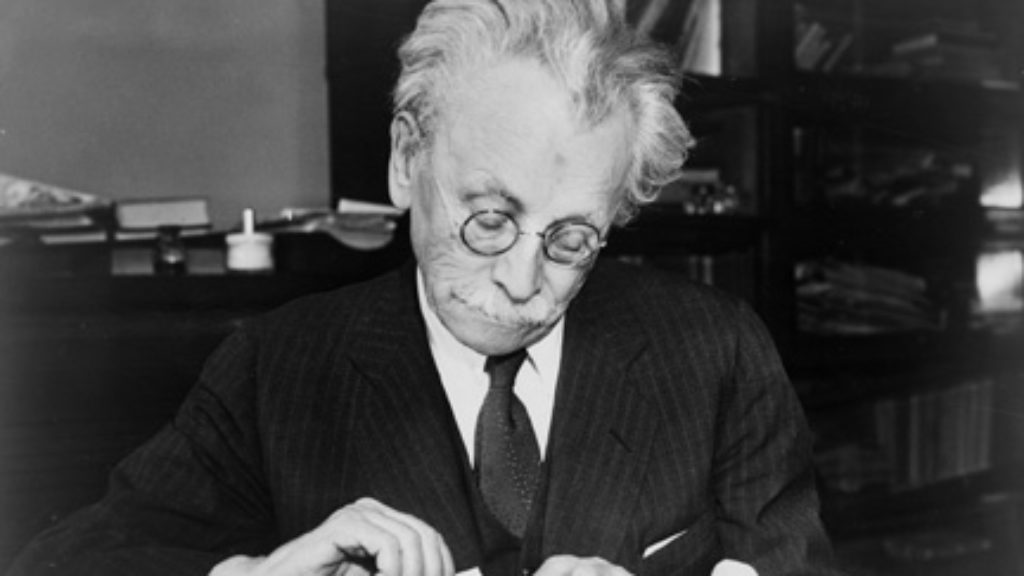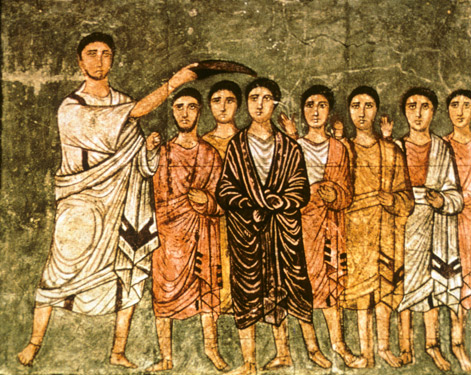Who Is David?
David looms large in the biblical imagination. His compelling story occupies not only much of First and Second Samuel and (in a reworked version) much of the first book of Chronicles, but he is also presented as the author/patron of the Psalms and most resonantly as Israel’s ideal king. Messianic biblical hopes, as well as later classical Jewish and Christian messianic yearnings, look forward to the arrival of a new Davidic king who will restore Israel and usher in an era of lasting peace and prosperity. So it is unsurprising that scholars and lay readers remain fascinated by the biblical stories of David and the history, insofar as it can be made out, behind them.
In chapter 16 of the first book of Samuel, God sends His prophet Samuel to anoint the young David as king in place of Saul, who has lost His (and Samuel’s) favor. The rest of the book describes David’s many adventures as he rises to power and Saul’s falling fortunes as he tries to take David’s life. With Saul wounded in battle by the Philistines, the opening chapters of Second Samuel narrate the intrigues that result in David’s triumph over the remainder of Saul’s court and family, resulting in his being crowned king over Judah and then Israel, as well. Perhaps the best-known parts of the David story describe the unraveling of his family life, culminating in an unsuccessful coup by his son Absalom. The beginning of the book of Kings brings this story to its conclusion with the ascent of David’s son Solomon to the throne.
It is the David found in the two books of Samuel that the well-known American rabbi David Wolpe thoughtfully probes in David: The Divided Heart, published in the Yale University Press Jewish Lives series and recently optioned for blockbuster Hollywood treatment by Warner Bros. and director Ridley Scott. Wolpe tells us that he has been thinking about his biblical namesake for nearly 40 years, ever since his father inscribed his high school yearbook with a stanza about King David.
Wolpe is aware of recent biblical scholarship on this topic, but his interests are elsewhere, and historical criticism is not deeply integrated into his book. Rather, Wolpe wrestles with the ambiguous and at times confusing biblical text; he regularly draws insights from the way David has been portrayed by later rabbis, thinkers, poets, writers, and artists. His book is a series of suggestive meditations on David as lover and husband, fugitive, king, sinner, father, caretaker, and so on. In keeping with such a format, some key biblical episodes and passages are treated in depth, while others are mentioned only in passing or not at all.
Biblical scholars tend to reconstruct what probably occurred historically and then go on to dismiss large portions of the narrative as later expansions or apologetic fictions that mask the true story. Wolpe prefers to read the text as it currently stands, as one can see in his comments on the David and Goliath story. At the end of 1 Samuel 16:21–23 David is introduced to Saul and becomes his arms-bearer and the musician who calms his troubled spirit. But, as Wolpe notes, when David is apparently reintroduced to Saul in the middle of the Goliath story only a chapter later, “Saul seems not to know who the young David is.” Even more confusingly, at the end of the Goliath story one strand of the narrative has Saul meeting David only after he has slain the Philistine giant (1 Samuel 17:55–58). Rather than separating the text into distinct narratives, Wolpe suggests a variety of literary and psychological possibilities for the apparent confusion: “This could be a product of inattention, of Saul’s depression, or of the Bible’s tendency in Samuel to give us snapshots without regard for the narrative flow.”
Wolpe is also attentive to ambiguities within the Hebrew prose of the narrative. Thus after David’s son Absalom murders his half-brother Amnon because Amnon had raped Absalom’s full-sister Tamar, we are told that David “mourned over his son a long time” (2 Samuel 13:37). Wolpe acknowledges that most commentators assume David is mourning Amnon, but suggests that the phrase “his son” could also refer to the now-exiled Absalom, or even that the wording may be purposefully ambiguous so as to suggest he mourned the loss of both sons. In fact, Wolpe’s subtitle, “The Divided Heart,” highlights one of his central insights: “consistency in character is necessary in fiction for plausibility, but in life we routinely discover that we do things ‘unlike’ ourselves.” Rather than explaining away the many ambiguities and tensions in the biblical text, Wolpe argues that the biblical story illuminates our inconstant human condition and, in doing so, still speaks to us.
Wolpe writes for a wide audience, but his somewhat scattershot and associative style, along with his many erudite literary references, may occasionally lose more-general readers. On the other hand, his lack of footnotes may frustrate scholars seeking to locate the sources of some of his interesting literary references and allusions. At times, in fact, it is unclear whether he is adducing his own, new interpretation or drawing on classical rabbinic sources. For example, he suggests that Psalm 55 may express “David’s internal state facing yet another revolt,” from the northern tribes, led by Sheba son of Bichri, that broke out in the wake of Absalom’s death (2 Samuel 20). The Bible and the rabbis regularly link various Psalms to specific episodes in David’s life. Yet Midrash on Psalms actually connects the images of personal betrayal in Psalm 55 (“It is not an enemy who reviles me—I could bear that; it is not my foe who vaunts himself against me—I could hide from him; but it is you, my equal, my companion, my friend” (Psalm 55:13–14) to Ahithophel, Absalom’s chief advisor, a figure who seems to have once worked in David’s own court, not to Sheba, a Benjaminite who is unlikely to have ever been either a friend or ally of David’s.
While all of Wolpe’s musings about David or his attempts to apply the text to contemporary life are not equally compelling, as a professional scholar as well as a mere reader of the Bible, I found myself appreciating his efforts to humanize the biblical David, rather than treating his story as a heap of conflicting texts that mask the true David.

Joel Baden, who teaches at Yale Divinity School, has successfully packaged many of the arguments about the David narrative that have emerged from biblical historians trained at Harvard over the last few decades. The main thrust of this school of thinking is that we can recover a good deal of history from the books of Samuel once we recognize that it is really a defense of David, an apology for his brutal, ruthless career. The foundational support for this hypothesis comes from what are claimed to be analogous ancient Near Eastern texts dating from several hundred years before David’s time, particularly a document produced by the Hittite king Hattushili III, who rose to power in a coup d’état.
By reading the David stories against the grain, Baden believes we can recover a fairly accurate portrait of the historical king and his reign. Building on the work of scholars like P. Kyle McCarter, who wrote the Anchor Yale Bible commentary on Samuel, and Baruch Halpern, author of David’s Secret Demons: Messiah, Murderer, Traitor, King, the David Baden recovers is a thoroughly unsavory and manipulative warlord. In Baden’s view, “Far from being unreasonable, Saul was prescient. His fears were justified. Even as the Bible describes him as mentally unstable, the history it records proves the opposite.”
One of Baden’s most compelling pieces of evidence is a notice at the end of 1 Samuel 25 that Abigail joined David along with another of his wives named Ahinoam. Baden argues that since the only other Ahinoam mentioned in scripture was one of Saul’s wives (1 Samuel 14:50), this is the same Ahinoam and that Saul pursued David because he had made a bid for the crown by marrying the queen. This is suggestive, but Baden often pushes more meager evidence with what can only be called prosecutorial zeal. For example, with little if any evidence he claims that “Most likely, it was David who gave the Philistines the idea to attack from the north rather than from the south” in the battle at which Saul was mortally wounded. Based on this and some further speculation, he claims that “The only sensible historical conclusion is that David really did participate actively in the death of Saul.”
Most of Baden’s book turns on the assumption that there is a simple way to arrive at what must have occurred in history: Just invert what the Bible is telling us! For example, the Bible implies that David should have been more suspicious when he heeded Absalom’s plea to let Amnon come to the sheep-shearing at which he was murdered. Baden claims that what really happened was that David colluded with Absalom to murder Amnon because Amnon’s mother was Ahinoam, who had been married to Saul, thus linking Amnon to Saul’s lineage. Even Absalom’s flight to Geshur for three years was really scripted by David and Absalom with Joab’s help, as Baden would have it. But why is this scenario more historically plausible than the biblical story as it stands?
J. Randall Short’s The Surprising Election and Confirmation of King David is not a work of popular scholarship. In fact, it is a revised dissertation, published in a distinguished monograph series five years ago, but it hones in on the weaknesses in the approach of Baden and the other extreme David skeptics. As he points out, the biblical account of David’s career is actually very different from the apology of the Hittite king Hattushili. King Hattushili openly acknowledges that he seized the throne, while the Bible tells us time and again that David avoided seizing the throne even when he had ample opportunity to kill Saul. In 1 Samuel 24:5 David stealthily cut off a piece of Saul’s cloak while Saul relieved himself in a cave, and in 1 Samuel 26:9–11 David rebukes Abishai (Joab’s brother) for seeking leave to kill Saul when they encounter the sleeping king.
Another compelling point Short highlights is that the Hittite text portrays Hattushili as completely innocent, while many texts in the so-called Davidic apology portray David in a very unflattering light. If these texts were written to defend David, then whoever wrote them botched the job. Couldn’t a talented author, or even a court hack, have easily fabricated less complex and ambiguous stories? Why all the shades of grey? As Wolpe aptly points out, “the attempt to turn David into a Machiavellian thoroughbred does violence to the complexity of his character,” and saying that “David is not above subterfuge . . . does not mean that every seeming subterfuge is David’s.”
It is worth underlining that for over two thousand years most Jews and Christians read these accounts and found little indictment of David in them. As Short’s book title indicates, what modern scholars tend to see as apologetic fabrication and political spin may have more to do with the important biblical theme of David’s special election than special pleading. Short’s teacher Jon D. Levenson’s masterful study of this motif, The Death and Resurrection of the Beloved Son: The Transformation of Child Sacrifice in Judaism and Christianity, explored the various texts in which the younger or youngest and thus least likely son is favored by God. The difficult journey these figures pass through turns out to be a marker of their elect status.
Short’s attention to the profound theological dimension of the biblical text allows him to see the many flaws in David’s character as similar to, say, those of Jacob. Like Jacob, David remains divinely favored in spite of his imperfect character and sometimes morally dubious behavior; his election does not depend upon his virtue. Short also notes that the preservation of this literature within the wider Tanakh, and especially the way in which various Psalms recited by the later community came to be linked to incidents in David’s life, suggests that ultimately the unlikely story of David’s rise and survival is mirrored in the equally unlikely story of the rise and continued persistence of the small and late-born people of Israel.
Jacob L. Wright’s cutting-edge study of the David narratives, although written in accessible prose, contains a number of complex and fairly technical arguments. Wright, who teaches at Emory University, seeks to uncover the growth and development of the biblical materials surrounding the figure of David. “Taken together, the biblical writings,” he says, “may be compared to war monuments that have accumulated new layers of meaning thanks to the many generations and rival groups through whose hands they have passed in their precanonical history.” Wrights theorizes that much of First and Second Samuel is composed of three distinct textual layers. First there was a narrative describing Saul’s rise to power among the northern tribal groups—that is, Israel—which made no mention of David or Judah. Then there was another story describing David’s rise to power in Judah, which made no mention of Saul. Finally, a third set of passages sought to weave together the previously distinct David and Saul stories by making them rivals. If Wright is correct, then the historical David never came into conflict with Saul and, contrary to Baden, the David story isn’t an apology for a usurper. It is, rather, a belated Judahite attempt to appropriate the illustrious history of the northern kingdom, Israel. One gets a sense of just how radical Wright’s historical reconstruction is when he writes that “it is quite possible that not only Absalom but also Solomon was not originally portrayed as David’s son.”
Wright’s book is part of a broader argument in the world of biblical studies between the so-called documentarians—who think that substantial blocks of the biblical text stem from a redactor who brought together discrete, original, pre-existing sources—and scholars like Wright who think that the Bible largely evolved layer upon layer, through textual accretion or supplementation. To be a little more precise, Wright actually aims at a hybrid approach that acknowledges the existence of something like the biblical sources that the documentarians have posited for the last two centuries while arguing that these sources, as well as the larger blocks of biblical material that evolved over time, grew into their current form through an extensive process of textual addition.
Wright’s approach sheds light on the origins of the biblical text, but it also has serious limitations. There are indeed cases of wide scholarly agreement about which parties might have written a particular source or inserted a specific editorial comment. But more often one finds that there are as many speculative reconstructions as there are scholars. Moreover, attempts to link every oddity to a distinct textual layer that reveals a specific socio-historical situation tend to be both circular and reductive. If there is a textual difficulty, it must imply another textual layer, and if there is another textual layer it must reflect a distinct ideological agenda, and so on.
For example, in his discussion of 1 Chronicles 11 and 12 Wright notes that, contrary to what one might expect according to his previous arguments, the Gadites, a northern tribal group, are portrayed very positively, while “Surprisingly, this text presents Benjaminites and Judahites—the core of the post-exilic community that produced the Bible—much more ambivalently.” Wright suggests a possible explanation for this anomaly, arguing that the wish to link reward to behavior and to be inclusive toward trans-Jordanian communities overrode the pro-Judean bias. But one sometimes wonders whether any evidence could call into question Wright’s speculations about the many layers he finds in the Bible.
This is not to say that Wright’s work is not instructive (and it is always ingenious). His war memorial analogy is helpful, for instance, in explaining why we might have the plethora of minor characters who assist or hinder David (for instance, Ittai the Gittite, Shimei son of Gera, and so on). As later generations appropriated the text, they wove their own concerns and heroes into it.
Nonetheless, it seems to me that Wright spends too little time on the biblical text as we have it. When he does touch upon interesting details, he often attributes them to issues outside of the frame of the story. For example, he argues that Ahithophel’s advice to Absalom to kill David with a minimum of bloodshed is meant to be contrasted with “the atrocious slaughter perpetrated by David’s professional fighters” in order to teach later audiences about “the brutal costs imposed by centralized rule, even while acknowledging its utilitarian value.” But this overlooks the fact that Ahithophel is depicted as every bit as brutal and utilitarian as David. The Bible tells a more complicated story: Ahithophel’s plan was unsuccessful because David’s spy Hushai played on Absalom’s vanity, convincing him that it would be more glorious to lead a huge army into battle, and also because “the LORD had decreed that Ahithophel’s sound advice be nullified, in order that the LORD might bring ruin on Absalom” (2 Samuel 17:14).
Wright notes in passing that the combination of once free-standing narratives together with later textual additions and subtractions has the occasional effect of creating characters that now appear to be ambiguous. Here I think he understates matters. For a great many of the characters in, for example, Second Samuel 9–20 and First Kings 1–2, are ambiguous. But why not attribute this to literary artistry, to a brilliant writer who has brought together a richly textured portrait of the events, precisely so that the characters and their actions can be interpreted in more than one way?
Similarly, Wright overlooks the many thematic and verbal connections between the Joseph story in particular—and the book of Genesis in general—and David’s familial troubles. It is striking that both stories have a Tamar who is involved in an inappropriate sexual act and that the words ketonet passim are found only in the description of Joseph’s special garment in Genesis 37 and one the worn by Tamar in 2 Samuel 13:18. Moreoever, David’s passivity after Tamar’s rape eventually results in the violent deaths of Amnon and Absalom, while Jacob’s passivity following Dinah’s rape is followed by Simeon and Levi’s violence against the men of Shechem and their subsequent demotion in status.
These and a host of other intertextual connections, seized upon by both ancient midrash and modern literary analysis, suggest that some of the biblical text’s developments might be better explained as a literary process. As Yair Zakovitch has argued, biblical stories with similar motifs seem to borrow from each other. In fairness, Wright’s own detailed speculations about the many layers of supplementation in the biblical text may help provide a model for understanding how such processes eventually gave birth to late Second Temple books such as Jubilees, which scholars speak of as a form of “rewritten Bible,” as well as, eventually, midrash. Wright is indeed good at highlighting the many unusual details in the text, but ultimately he is less effective at illuminating the story of David that we actually have in front of us.
Can the David reconstructed by historians speak to the theological concerns of Jews and Christians, or even to those who read the Bible as a literary masterpiece? Is there no irony in the fact that historical critics like Baden and Wright, who seek to recover the lost history behind the text in hopes of bringing us a richer view of the Bible, often flatten the portrait of David that is presented in First and Second Samuel?
The fact that David Wolpe’s literary-religious reflections and Joel Baden’s historical excavations recover such different portraits of David suggests that we have much to learn from literarily and theologically attuned readings as well as from hard-nosed historically informed ones. Yet it seems to me that Wright and Short employ a broader and more integrated approach. Although Wright’s readings are sometimes forced, his book attempts to explain how ancient Judeans made historical and theological sense of their experience and how the biblical text reflects that process. Short’s book goes even further by focusing on a—arguably the—central biblical concern, that of God’s inscrutable choice of Israel, and shows how it animates the story of King David. Short demonstrates that David’s compelling and all-too-human story is also deeply theological. The theological dimension of the text—on which Jews and Christians have so creatively focused for millennia—is not a diversion from its real meaning but rather key to it.
Suggested Reading

When Eve Ate the Etrog: A Passage from Tsena-Urena
There was once a custom for a pregnant woman to bite off the tip of the etrog at the end of Sukkot. This excerpt includes the text of a Yiddish prayer, or tkhine, that the pregnant woman is instructed to recite based on an interpretation of Genesis 3:6.

Eden in a Distant Land
A new biography of Abraham Cahan unpacks how a young immigrant from Lithuania created the Forward and changed American Jewry.
Sincere Irony
In a new book about religious moderation, William Egginton makes some good points, along with a few immoderate claims.
More Important Things
Francesca Segal's prize-winning The Innocents: A generous, garrulous, and utterly genuine group portrait of Anglo-Jewry.


Comments
You must log in to comment Log In